Title of paper under discussion
Emotional responses to pleasant and unpleasant music correlate with activity in paralimbic brain regions
Authors
Anne J. Blood, Robert J. Zatorre, Patrick Bermudez and Alan C. Evans
Journal
Nature Neuroscience, volume 2 no 4, April 1999, pp382-387

Overview
Anne Blood and her colleagues at McGill University, Montreal set out to examine the human brain’s emotional response to music. By monitoring cerebral blood flow as participants listened to music they were able to locate changes in neural activity associated with hearing varying degrees of consonance and dissonance – and perceiving degrees of pleasantness and unpleasantness – in a series of ever more dissonant short musical extracts.
Dissonance, it turned out, was generally described as sounding ‘unpleasant’. Certain brain areas – including parts of the paralimbic cortex – commanded higher blood flow according to the emotion induced by the music, with activity in some such regions associated with ‘pleasant’ harmony, and activity in others with ‘unpleasant’ harmony. These particular “music emotion” brain regions – which were noted as being separate from “music perception” regions – were similar to ‘pleasantness’ and ‘unpleasantness’ regions in previous experiments where the stimulus was visual, not musical.
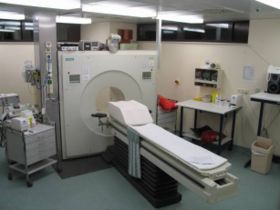
Method
Ten volunteers, five men and five women, listened to a novel melody on synthesised piano whilst in a brain scanner (using positron emission tomography, or PET). The same melody was heard six times, but each time with a different accompaniment: major triads, dominant 7ths, 9ths, 11ths, 13ths and flatted 13ths.
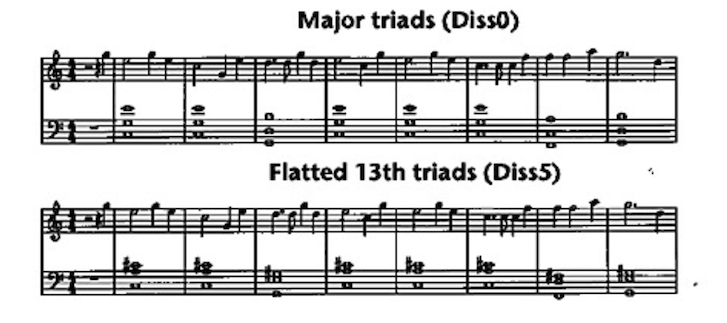
After each hearing of the melody the participant was asked to rate it in terms of pleasantness (up to +5 points) or unpleasantness (down to -5 points).
In addition to the series of melodies, ‘noise bursts’ – excerpts of white noise of similar length and loudness to the melody – were played to the participants as a control procedure.
Brain activity throughout the experiment was monitored by the scanner.
Results
The higher the level of dissonance, the more likely a participant was to judge that harmonised melody as unpleasant:
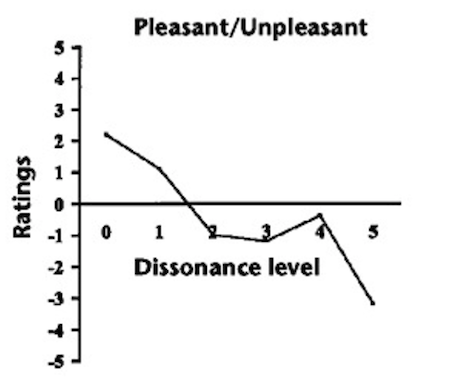
Distinct areas of the brain saw changes in activity depending on whether the music was more consonant or more dissonant. Specifically, activity in the right parahippocampal gyrus and the precuneus regions was correlated with musical dissonance:
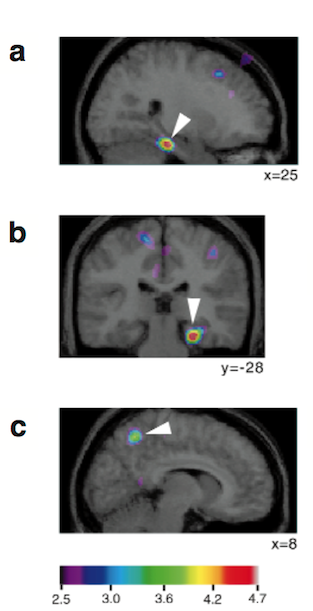
whereas activity in orbitofrontal, subcallosal and frontal polar cortex was associated with musical consonance:
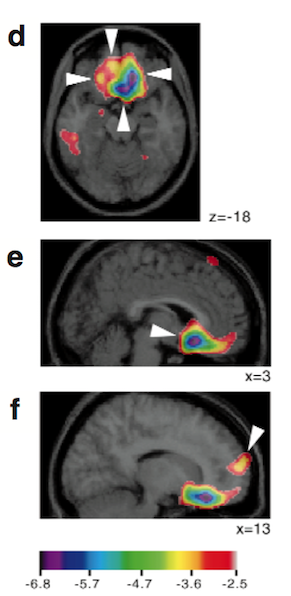
[Our researchers analysed the imaging data in three different ways – correlation between brain activity and consonance/dissonance levels (as depicted above), subtraction of brain activity during consonance from brain activity during dissonance, and covariation of dissonance/consonance-related brain activity between different brain regions. All three approaches supported the brain activity location patterns described above]
Unsurprisingly, an analysis of the correlation between brain activity and perceived ‘unpleasantness’ or ‘pleasantness’ yielded a similar pattern of results. ‘Musical unpleasantness’ correlated with brain activity in the right parahippocampal gyrus (and the posterior cingulate cortex):
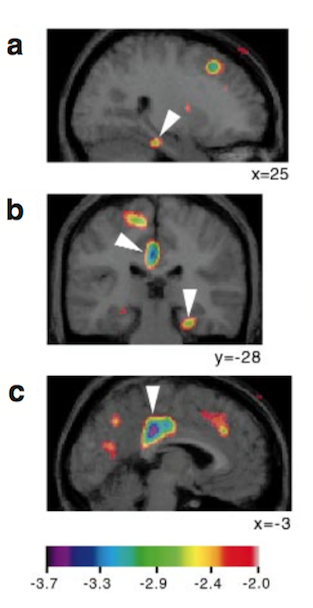
whereas ‘musical pleasantness’ correlated with activity in orbitofrontal and subcallosal cortex:
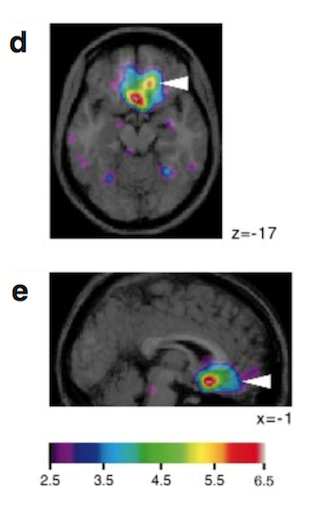
Finally, by comparing the brain scans taken during both consonant and dissonant melody examples with those taken during ‘noise bursts’, Blood and her colleagues found that the superior temporal cortex was active during ‘music perception’ (that is, whilst listening to the melody) but not during ‘noise perception’ (listening to the ‘noise bursts’).
Discussion
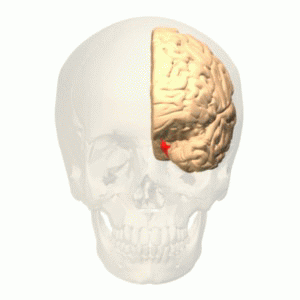
The authors highlight the parahippocampal gyrus as an area consistently associated with dissonant and ‘unpleasant’ music, and note – intriguingly – that previous research has identified the same region as active when participants view unpleasant pictures:
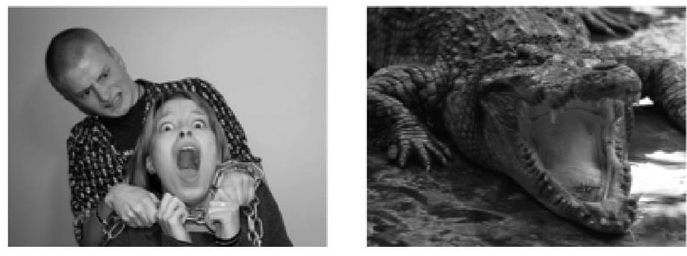
Also discussed is the subcallosal cortex, an area associated with musical consonance and pleasantness. Dr Blood notes that this region has been identified in previous research as underactive in people with depression, a finding that accords with this paper “because activity in the subcallosal region decreased with unpleasantness, whereas it increased with pleasantness [of the music].”
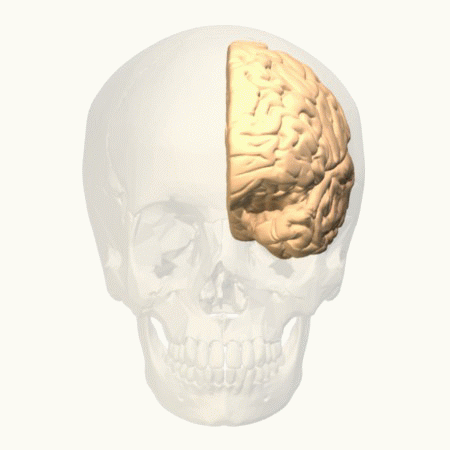
Another important finding was, according to the authors, the distinction between brain activity during “music perception” (centred around the superior temporal gyrus) and “music emotion” (the areas described in the scans above). They do, however, suggest that “circuitry related to the emotional components of music may be anatomically proximal [close] to that used during more perceptual processes.” They go on to postulate that most of the increase in brain activity revealed in this study was found in the right hemisphere because most emotional processing is thought to take place on that side of the brain. And they note that one important emotional response nucleus, the amygdala, did not feature as showing increased activity in this particular research; however the amygdala is especially implicated in the processing of fear, so its ‘silence’ in this study of pleasantness/unpleasantness demonstrates, according to our researchers, how different emotions are specific to different brain regions.

In summary, writes Dr Blood, “The findings of this study not only begin to define a neural network associated specifically with emotional responses to music, but also demonstrate dissociations from other important cognitive processes.”
Coda
Partitions, for piano (1957) – Milton Babbitt
piano – Augustus Arnone
“Pleasant and unpleasant”. Already subjectivity. The presumption that all listeners find dissonance “unpleasant” is objectively objectionable.
How about approaching it with terms like “common and Interesting”? Using words like pleasant and unpleasant are too suggestive. Many of the studies I’ve read are tainted by their suggestive terminology.
But even this admirer of dissonant music finds Milton Babbitt’s music unappealing. Never been a fan of much music conceived combintorially. Many of the Brits use Magic Squares. Strict dodecaphonically written music can be beautiful and exciting, but the most appealing are those where the composer has “cheated” on the strictures of the method. Berg, Henze, and others whose melodic and harmonic sensibilities guided their 12 tone rule-breaking, created the most ravishing Dodey music.
Hi James, thanks for the comment! There were actually further emotions suggested to participants I didn’t include in my summary: “…behavioral ratings of unpleasant versus pleasant, tense versus relaxed, irritated versus unirritated, annoying versus unannoying, dissonant versus consonant and angry versus calm were found to interact significantly .. with dissonance level. These ratings also had positive correlation coefficients with dissonance level, ranging from 0.62 to 0.39…. Higher levels of dissonance were correlated with higher average ratings of adjectives associated with negative emotions (that is, unpleasant, tense, irritated, annoying, dissonant and angry), whereas higher levels of consonance were correlated with higher average ratings of adjec- tives associated with positive emotions (pleasant, relaxed, unirritated, unannoying, consonant and calm). Ratings of bored versus interested and sad versus happy did not show significant interactions with amount of dissonance and had correlation coefficients of 0.18 and 0.33, respectively…” PS I love the term Dodey music – an Orleansism? – and totally agree that its beauty often comes with some rule bending. Webern perhaps the most ravishing?